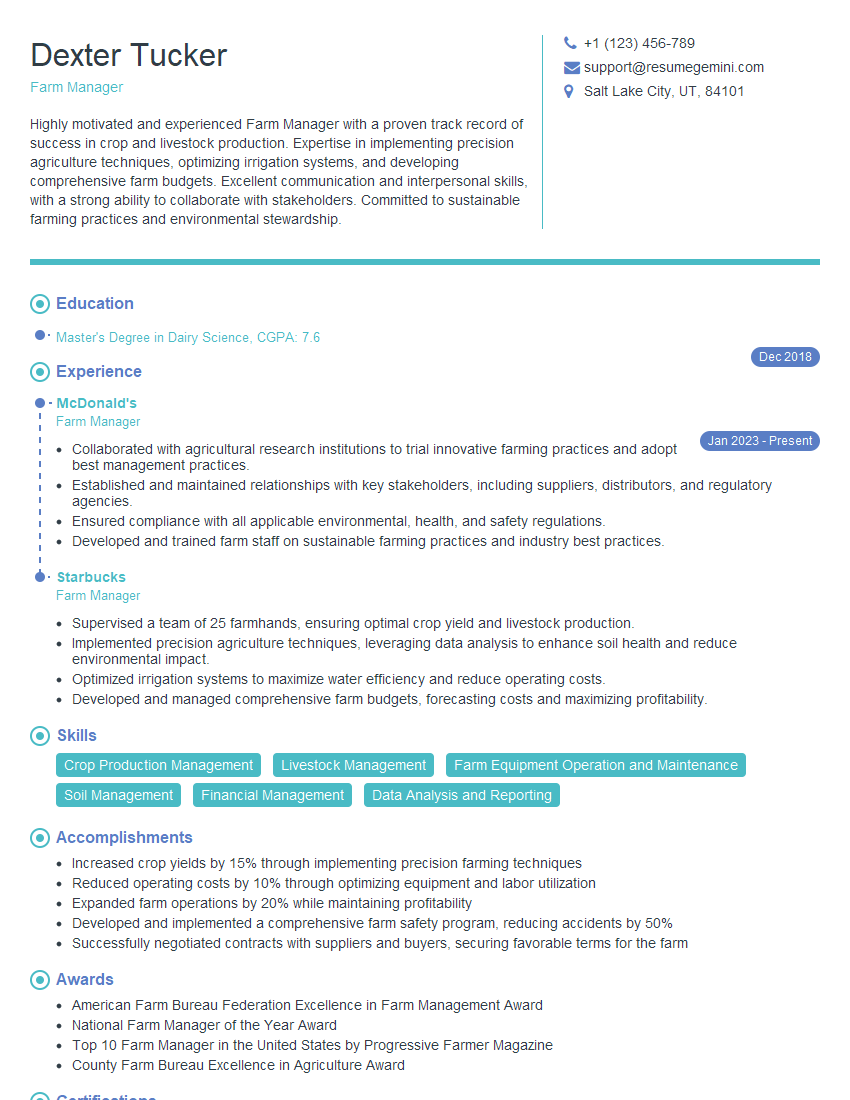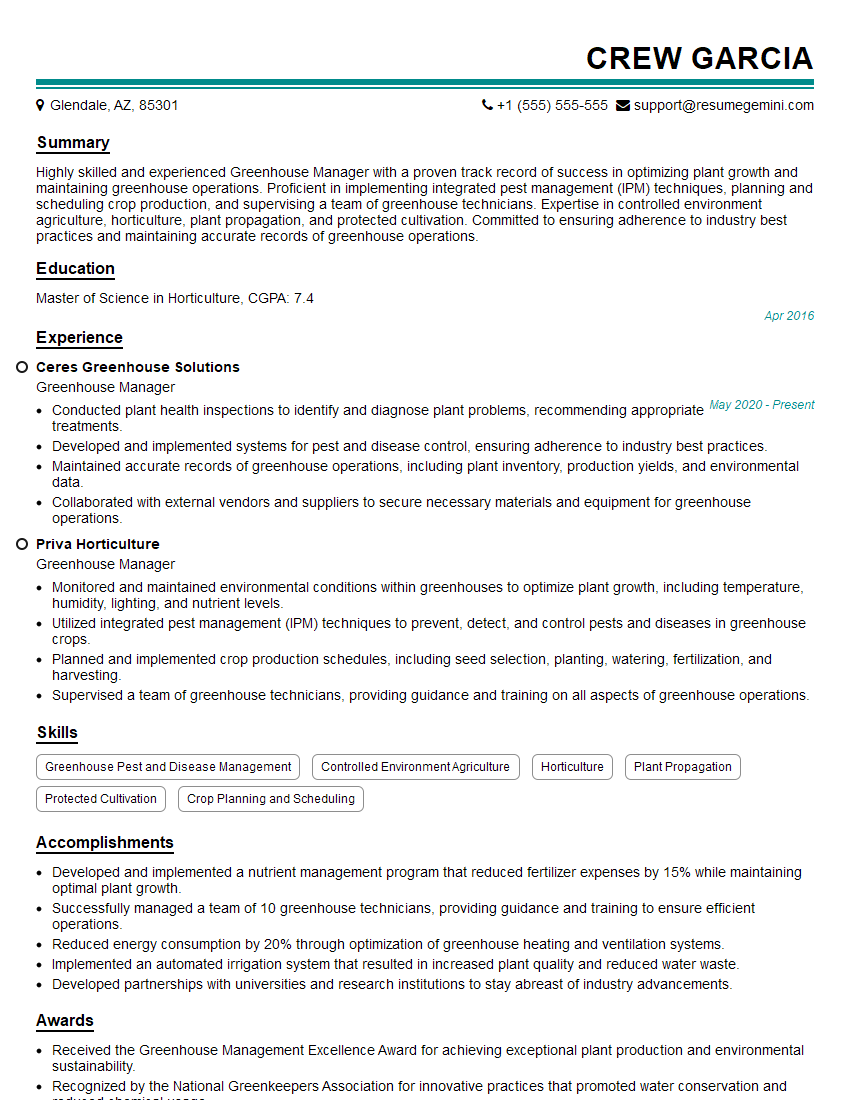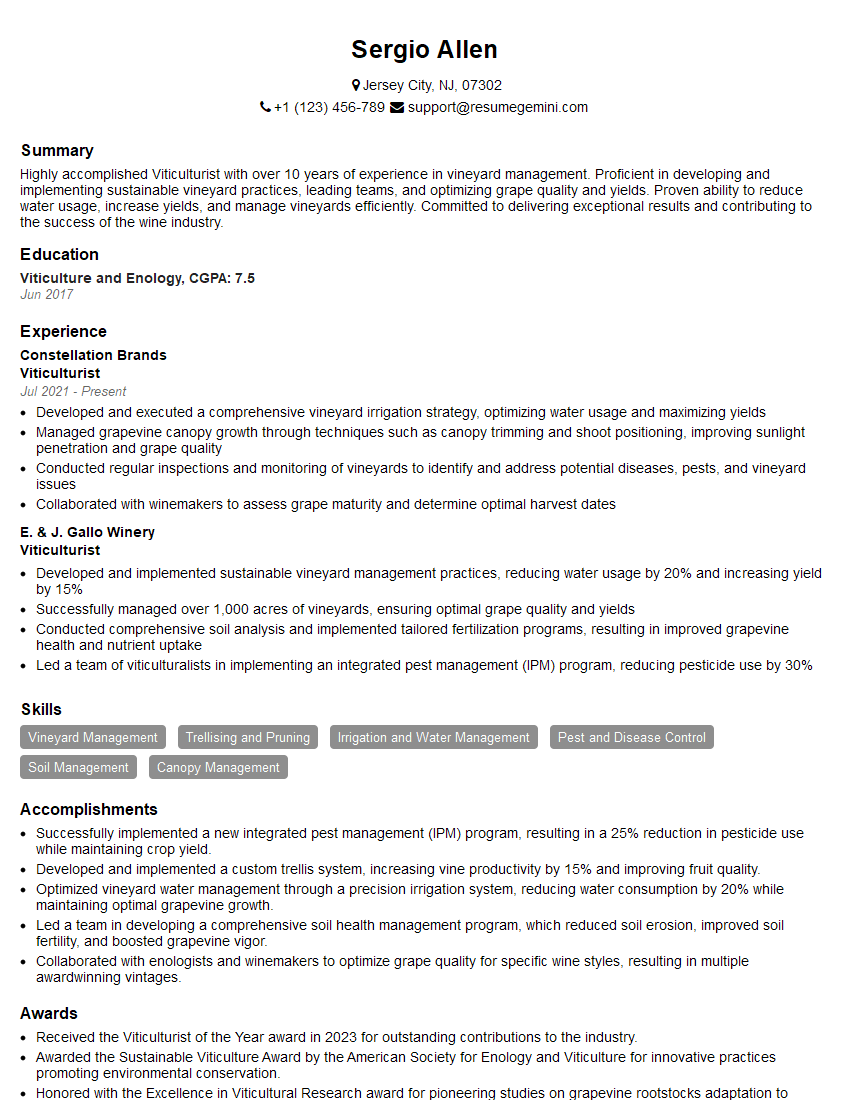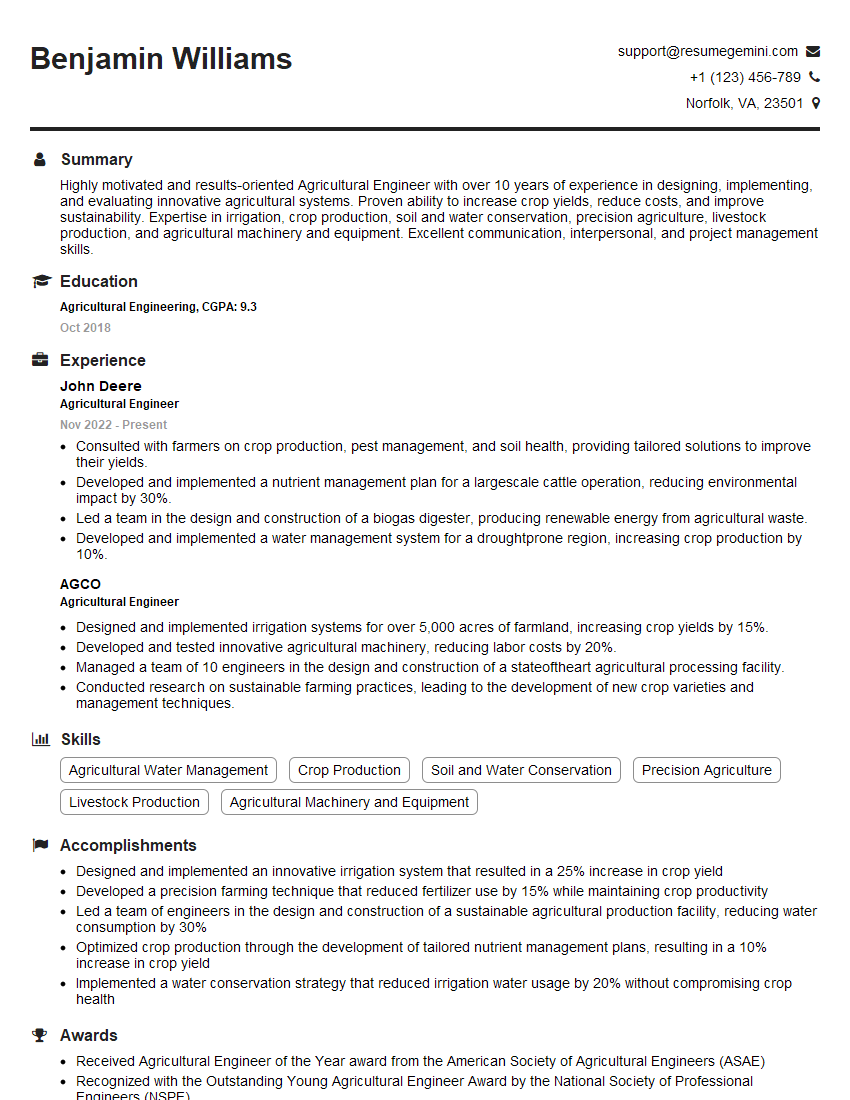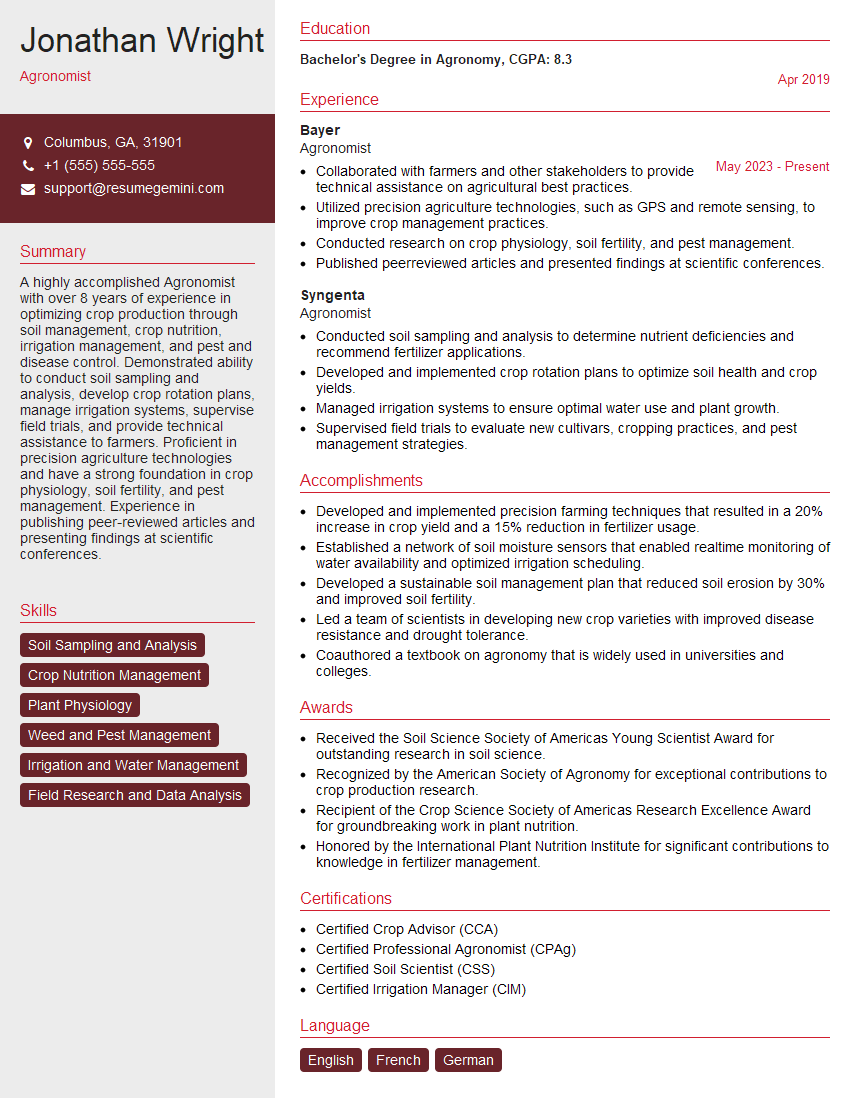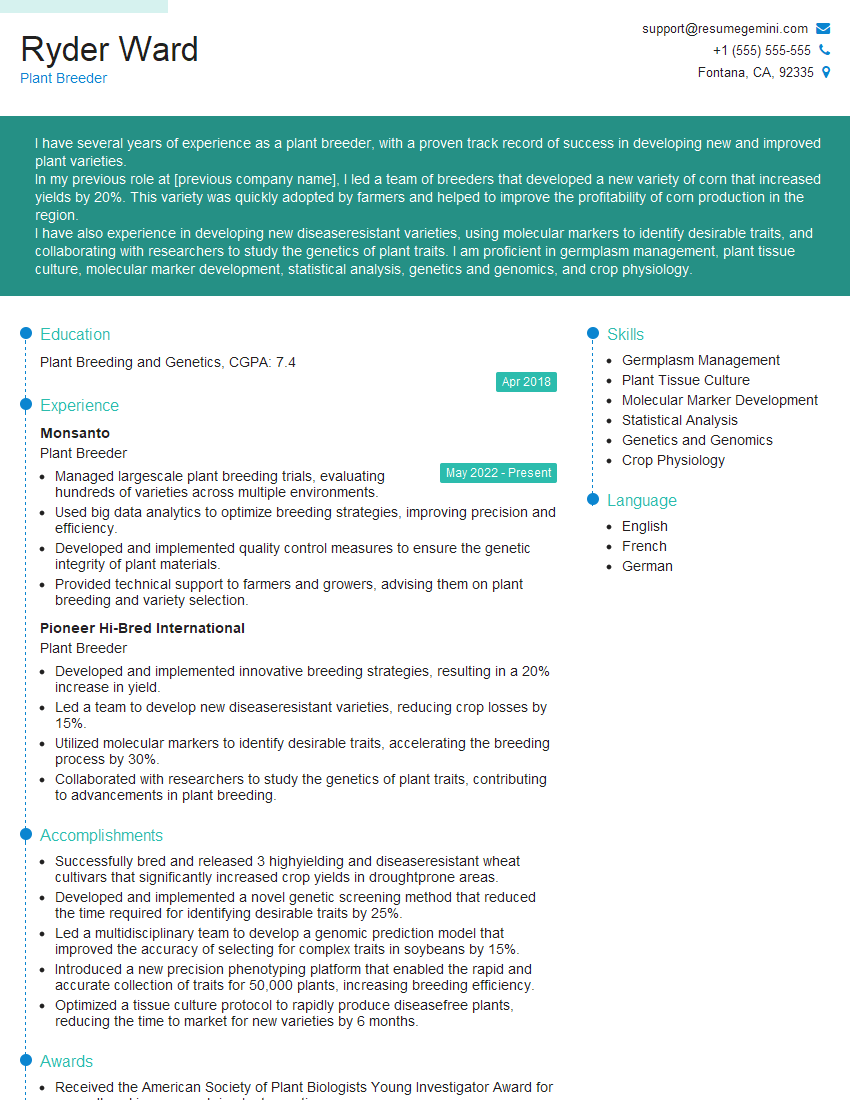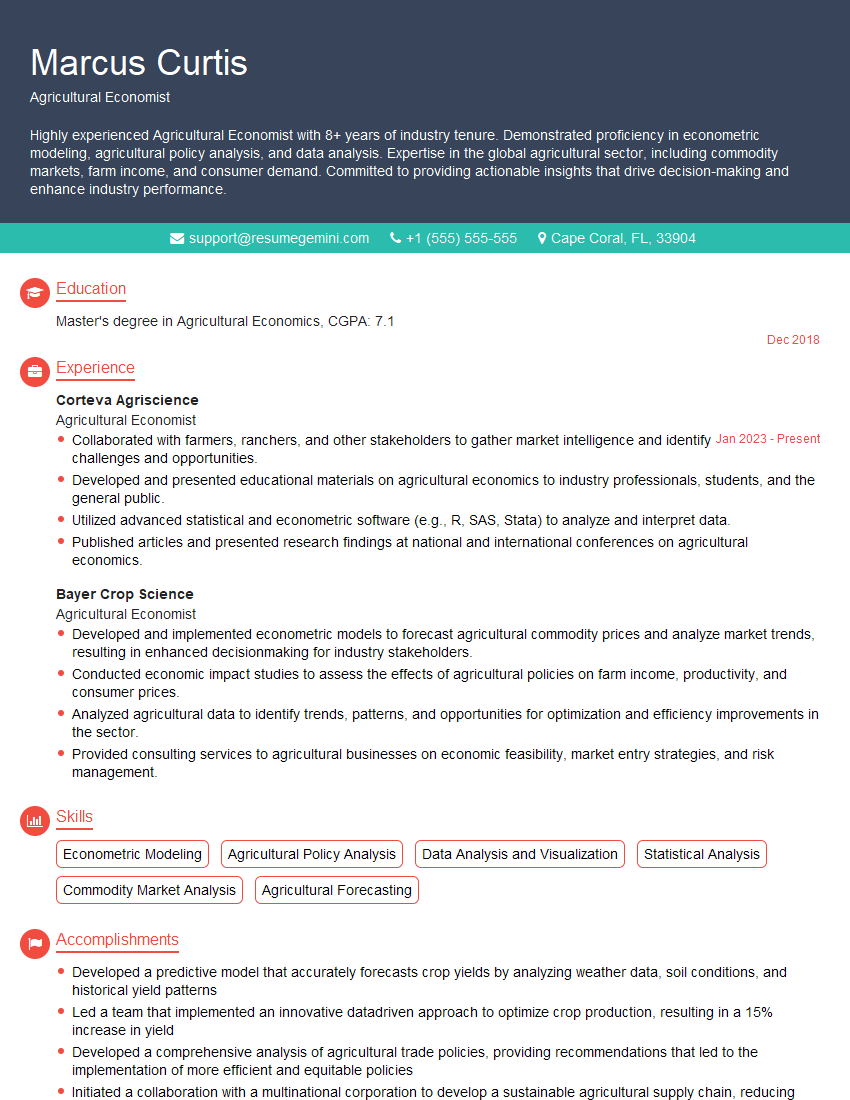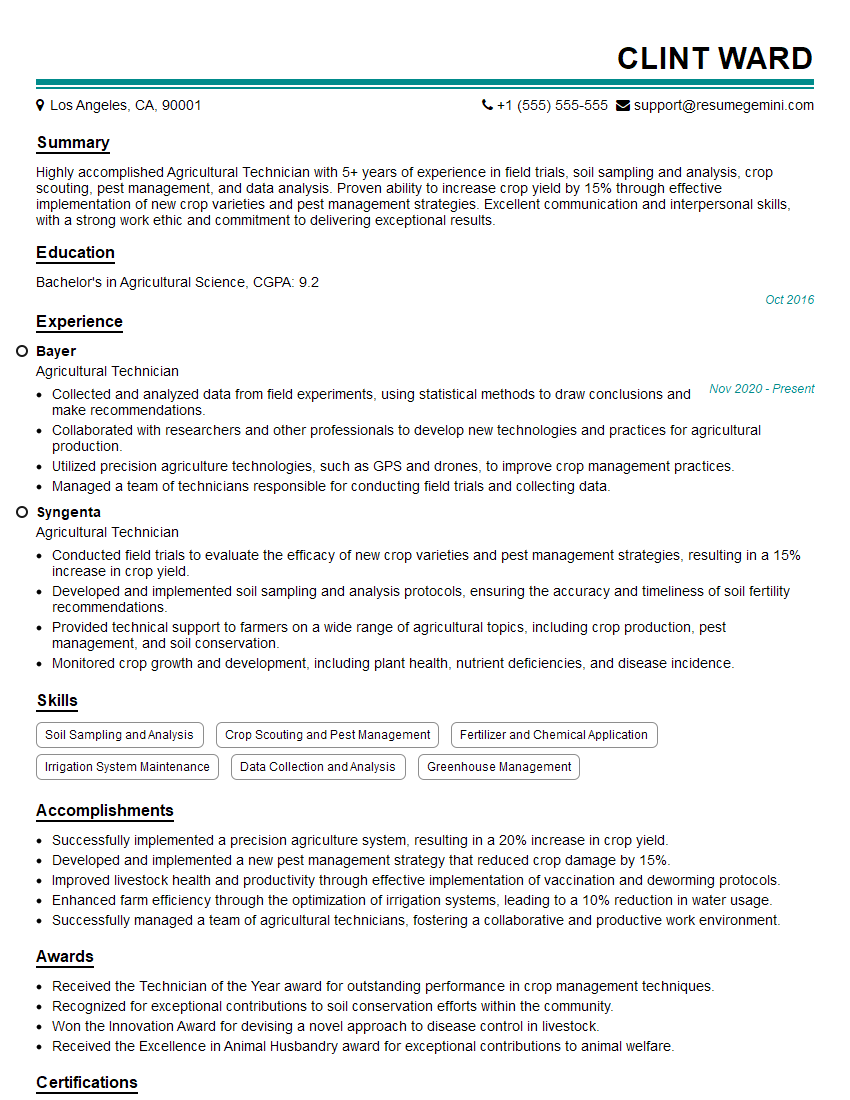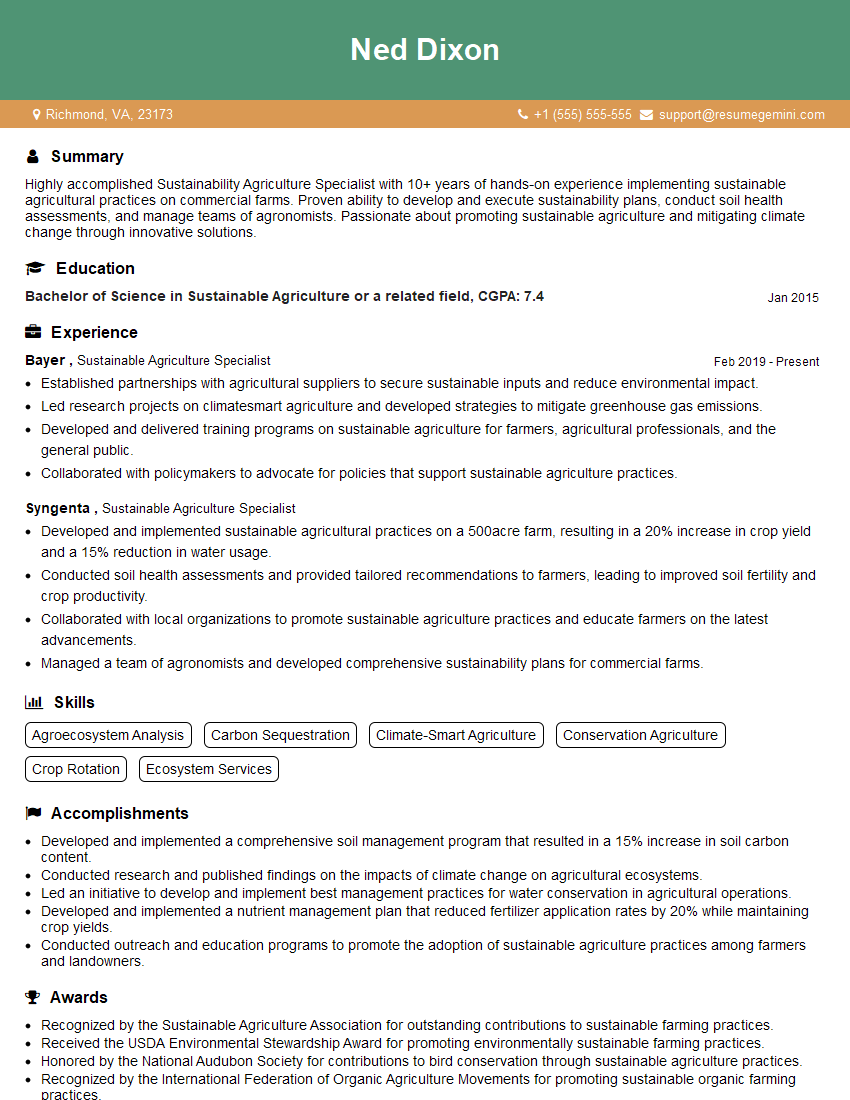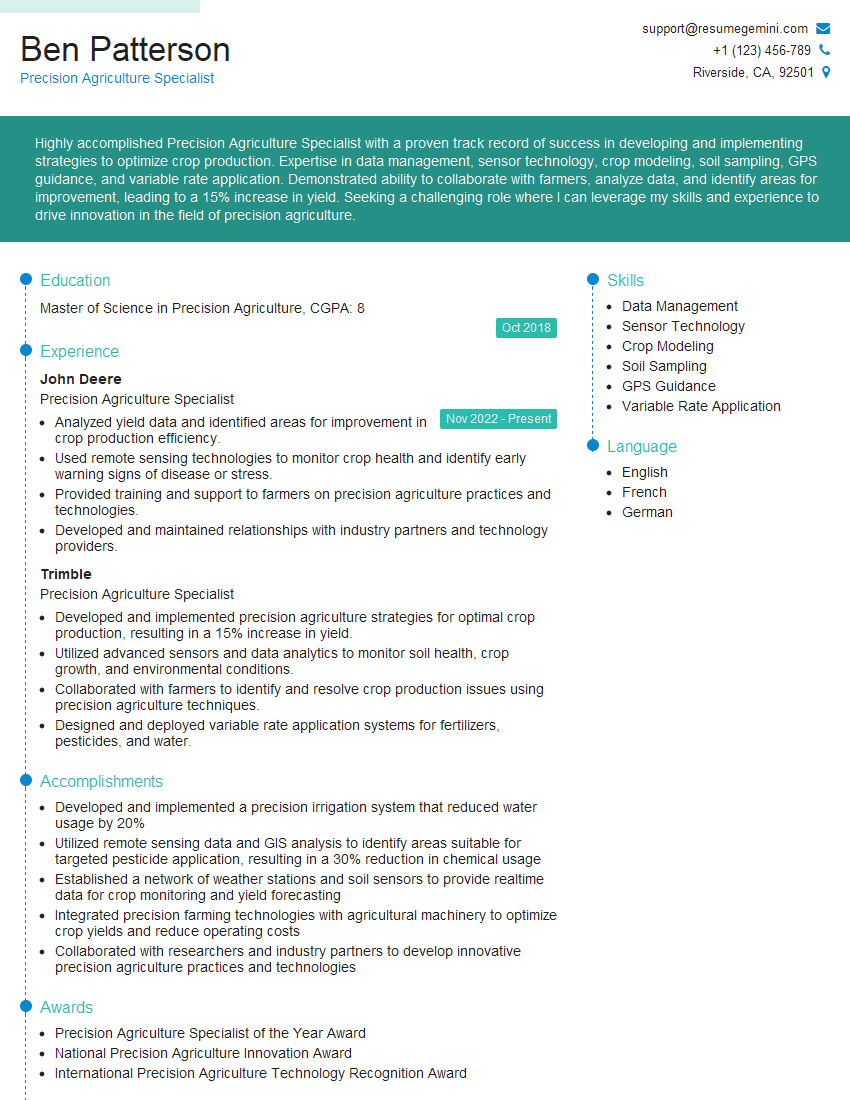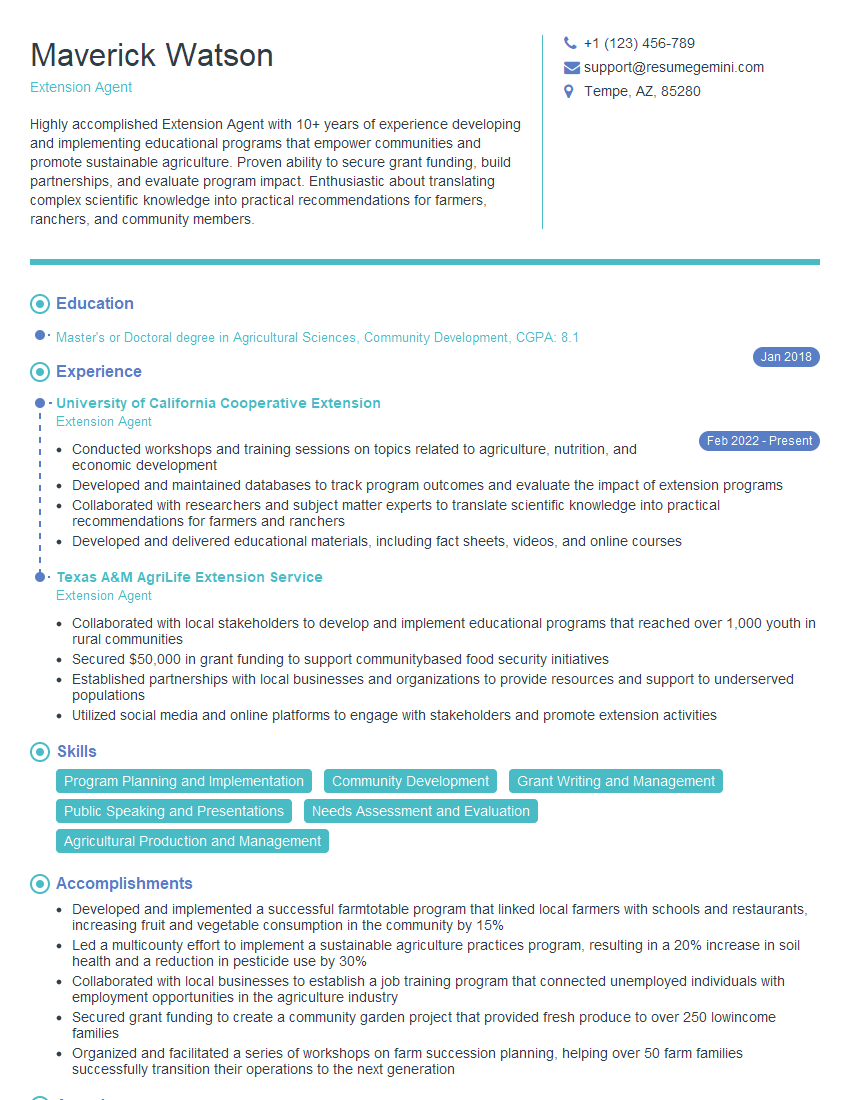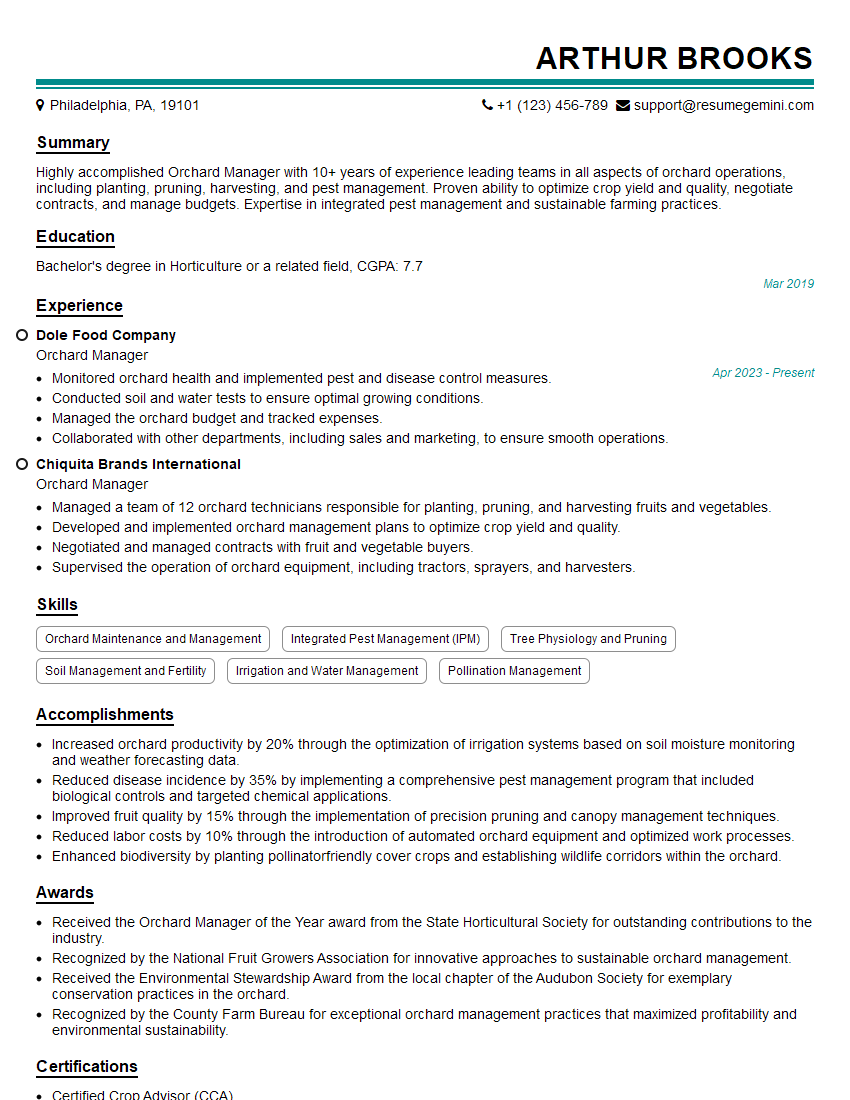Are you ready to stand out in your next interview? Understanding and preparing for Agronomic Practices and Crop Production interview questions is a game-changer. In this blog, we’ve compiled key questions and expert advice to help you showcase your skills with confidence and precision. Let’s get started on your journey to acing the interview.
Questions Asked in Agronomic Practices and Crop Production Interview
Q 1. Explain the principles of soil fertility and nutrient management.
Soil fertility refers to the soil’s capacity to supply essential nutrients for plant growth. Nutrient management involves the strategic use of fertilizers and soil amendments to optimize nutrient availability. This is crucial for maximizing crop yields and maintaining soil health over the long term.
The principles revolve around understanding the soil’s nutrient content, plant nutrient requirements, and environmental factors. A key aspect is balancing nutrient supply with plant demand, avoiding both deficiencies and excesses. Deficiencies lead to stunted growth and reduced yields, while excesses can harm plants and pollute the environment.
- Soil Testing: Regular soil testing is crucial to determine nutrient levels and adjust fertilizer application accordingly. This helps tailor nutrient inputs to specific crop needs and soil conditions.
- Nutrient Cycling: Understanding nutrient cycling, including decomposition of organic matter and nutrient uptake by plants, is essential for minimizing fertilizer use and enhancing soil health. Cover crops and compost play vital roles in this process.
- Fertilizer Selection: Selecting the right fertilizer type (e.g., organic, inorganic) and application method is crucial to maximize nutrient uptake and minimize environmental impact. Slow-release fertilizers, for example, reduce nutrient runoff.
- Integrated Nutrient Management (INM): INM integrates various approaches like organic amendments (compost, manure), biofertilizers (nitrogen-fixing bacteria), and balanced mineral fertilizers for a holistic approach to nutrient supply. This minimizes environmental damage and improves soil biodiversity.
For example, a farmer might use soil testing to discover a phosphorus deficiency in their corn field. They could then amend the soil with phosphorus-rich fertilizer before planting, ensuring the corn has the nutrients it needs for optimal growth and yield.
Q 2. Describe different irrigation techniques and their suitability for various crops.
Irrigation techniques vary significantly, each with its strengths and weaknesses depending on the crop, climate, and available resources. Choosing the right technique can significantly impact yield and water efficiency.
- Drip Irrigation: Delivers water directly to the plant roots through a network of tubes and emitters. This is highly efficient, minimizing water loss through evaporation and runoff. It’s ideal for high-value crops like fruits and vegetables.
- Sprinkler Irrigation: Distributes water over a larger area using sprinklers. While less efficient than drip, it’s suitable for larger fields and crops that need more even moisture distribution. Variations include center pivot and travelling gun systems.
- Flood Irrigation: Involves flooding the field with water. This is the least efficient method, prone to waterlogging and runoff, but can be suitable for crops tolerant to temporary waterlogging and in areas with low labor costs.
- Furrow Irrigation: Water flows in furrows between crop rows. This method is relatively inexpensive but can be inefficient with water loss through runoff and evaporation.
The choice of irrigation method depends on several factors. For instance, drip irrigation is best for water-sensitive crops like tomatoes in arid regions, while sprinkler irrigation is often preferred for larger fields of grains or forage crops. Flood irrigation might be used in rice paddies where waterlogging is tolerated.
Q 3. Discuss the impact of climate change on crop production and mitigation strategies.
Climate change poses a significant threat to crop production globally. Changes in temperature, rainfall patterns, and the frequency of extreme weather events (droughts, floods, heatwaves) are already impacting crop yields and quality.
- Increased Temperatures: Higher temperatures can reduce crop yields, shorten growing seasons, and increase the risk of heat stress in plants.
- Altered Rainfall Patterns: Changes in rainfall patterns can lead to droughts in some regions and floods in others, both causing major crop losses.
- Increased Pest and Disease Prevalence: Warmer temperatures and altered precipitation can favor the proliferation of pests and diseases, further reducing yields.
Mitigation strategies involve a multi-pronged approach:
- Developing Climate-Resilient Crops: Breeding and selecting crop varieties that are tolerant to drought, heat, and salinity is crucial.
- Improved Water Management: Implementing efficient irrigation techniques and water conservation practices to minimize the impact of droughts.
- Sustainable Soil Management: Practices such as no-till farming and cover cropping enhance soil health and resilience to climate change impacts.
- Precision Agriculture: Using technology like sensors and data analytics to monitor crop health and optimize resource use.
- Carbon Sequestration: Agricultural practices that sequester carbon in the soil can help mitigate climate change.
For example, farmers in drought-prone areas might shift to drought-resistant crop varieties or adopt water-efficient irrigation techniques like drip irrigation. Promoting agroforestry can also provide shade and reduce water evaporation.
Q 4. How do you manage pest and disease infestations in crops?
Pest and disease management is critical for maintaining crop health and maximizing yields. It involves a combination of strategies that prioritize prevention and minimize reliance on chemical pesticides.
- Integrated Pest Management (IPM): IPM is a holistic approach that combines various techniques to control pests and diseases. It emphasizes monitoring pest populations, using preventive measures, and employing targeted interventions only when necessary.
- Crop Rotation: Rotating crops disrupts pest and disease cycles, reducing their impact.
- Biological Control: Utilizing natural enemies of pests, such as beneficial insects or microorganisms, to control pest populations.
- Resistant Varieties: Planting crop varieties that are resistant to specific pests and diseases can significantly reduce losses.
- Chemical Control: Chemical pesticides are used only as a last resort, and when used, it should follow strict guidelines to minimize environmental impact and human health risks.
- Cultural Practices: Practices like proper sanitation, crop hygiene, and appropriate planting densities can reduce pest and disease pressures.
An example of IPM might involve monitoring for aphids in a field of lettuce. If the aphid population remains low, no action is needed. However, if the population grows beyond a certain threshold, a biological control agent like ladybugs could be introduced, alongside adjustments in cultural practices like improving ventilation.
Q 5. Explain the principles of crop rotation and its benefits.
Crop rotation involves planting different crops in a planned sequence on the same piece of land over several growing seasons. It’s a fundamental sustainable farming practice with numerous benefits.
- Improved Soil Health: Different crops have different nutrient requirements and root systems. Rotating crops helps maintain soil fertility by preventing nutrient depletion and improving soil structure.
- Pest and Disease Management: Rotating crops disrupts the life cycles of many soilborne pests and diseases, reducing their populations and minimizing the need for chemical controls.
- Weed Control: Some crops suppress weeds more effectively than others. Crop rotation can help manage weed populations.
- Increased Biodiversity: Crop rotation promotes biodiversity above and below ground, enhancing soil ecosystem health.
- Improved Water Use Efficiency: Some crops have different water requirements. Rotation can improve water management and reduce water stress.
For instance, a farmer might rotate corn (heavy feeder), legumes (nitrogen fixer), and a small grain (low nutrient demand) in a three-year cycle. Legumes help replenish soil nitrogen, corn utilizes the nitrogen, and the small grain improves soil structure. This is a simple example; rotations can be more complex depending on specific needs and soil conditions.
Q 6. What are the key factors influencing crop yield?
Crop yield, the amount of produce harvested per unit area, is influenced by a complex interplay of factors. Optimizing these factors is crucial for achieving high and consistent yields.
- Genetics: The inherent genetic potential of the crop variety significantly impacts yield. High-yielding varieties are critical.
- Soil Fertility and Nutrition: Adequate supply of essential nutrients is fundamental for plant growth and development.
- Water Availability: Sufficient water is necessary for photosynthesis and overall plant function. Water stress significantly reduces yields.
- Climate: Temperature, rainfall, sunlight, and other climatic conditions greatly influence crop growth.
- Pest and Disease Pressure: Pests and diseases can severely reduce yields if not managed effectively.
- Management Practices: Proper planting density, weed control, fertilization, and pest management all contribute significantly.
- Soil Health: Soil structure, organic matter content, and microbial diversity impact nutrient availability and overall plant health.
For example, a farmer using high-yielding corn varieties, coupled with proper fertilization, irrigation, and pest control, will likely achieve a much higher yield than a farmer neglecting these aspects. Understanding the interactions between these factors is key to optimizing yield.
Q 7. Describe different methods of weed control.
Weed control is essential for maximizing crop yields by reducing competition for resources. Various methods are employed, often in combination.
- Cultural Control: Methods like crop rotation, proper planting density, and timely tillage can suppress weed growth.
- Mechanical Control: Physical removal of weeds using tools like hoes, cultivators, or mowers. This can be labor-intensive but effective for small-scale operations.
- Chemical Control: Herbicides are used to kill or inhibit weed growth. Careful selection and application are crucial to minimize environmental and health impacts. This requires knowledge of herbicide classes and their selectivity.
- Biological Control: Using natural enemies of weeds like specific insects or pathogens to reduce weed populations. This is a more environmentally friendly approach but can require specialized expertise.
- Integrated Weed Management (IWM): IWM combines multiple weed control methods to achieve effective weed suppression while minimizing reliance on herbicides and promoting sustainable agriculture. This is an increasingly popular approach.
For example, a farmer might use a combination of pre-emergent herbicides to prevent weed seeds from germinating, followed by post-emergent herbicides for any breakthrough weeds, and supplementing these with cultivation to control weeds between crop rows. This demonstrates an integrated approach.
Q 8. How do you assess soil health and fertility?
Assessing soil health and fertility involves a multifaceted approach, combining visual observation with laboratory analysis. Think of it like giving your soil a thorough check-up! We start with a visual inspection, noting the soil’s color, texture, and structure. Darker colors often indicate higher organic matter content, a key indicator of soil health. A crumbly structure is desirable, showing good aeration and water infiltration. Clayey soils, while fertile, can be prone to compaction and poor drainage.
Next, we take soil samples at various depths across the field. These samples are then sent to a lab for analysis. Key parameters include:
- pH: Measures soil acidity or alkalinity, influencing nutrient availability. An optimal pH range varies by crop.
- Organic Matter: Indicates the amount of decomposed plant and animal material, crucial for soil structure, water retention, and nutrient cycling. Think of it as the soil’s food.
- Nutrient Levels (Macro and Micronutrients): Determines the availability of essential elements like nitrogen (N), phosphorus (P), potassium (K), and micronutrients like zinc and iron, vital for plant growth. Deficiencies can lead to stunted growth and reduced yields.
- Cation Exchange Capacity (CEC): Measures the soil’s ability to hold onto positively charged nutrients, preventing them from leaching away.
- Texture (Sand, Silt, Clay): This determines water retention, drainage, and aeration capacity. A balanced mix is ideal.
Based on the lab results, we can develop a site-specific fertilization plan to optimize nutrient levels and improve soil health. For instance, if the soil is low in organic matter, we might recommend adding compost or cover crops to enhance soil structure and fertility naturally.
Q 9. What are the best practices for sustainable agriculture?
Sustainable agriculture focuses on producing food and fiber while minimizing environmental impact and ensuring long-term productivity. Imagine farming in a way that leaves the land better than you found it. Key practices include:
- Crop Rotation: Planting different crops in sequence helps break pest and disease cycles, improve soil health, and reduce nutrient depletion. For example, rotating legumes (like beans) with grain crops helps replenish nitrogen in the soil naturally.
- Cover Cropping: Planting crops like rye or clover during fallow periods protects soil from erosion, suppresses weeds, and adds organic matter. It’s like giving the soil a blanket to keep it warm and healthy.
- Integrated Pest Management (IPM): Employing a combination of biological, cultural, and chemical methods to manage pests, minimizing reliance on harmful pesticides. This involves monitoring pest populations and intervening only when necessary.
- Conservation Tillage: Minimizing soil disturbance during planting and cultivation to reduce erosion and improve soil structure. No-till farming is an example where seeds are directly sown into the soil without ploughing.
- Water Management: Implementing efficient irrigation techniques like drip irrigation to conserve water and reduce runoff. This targeted watering ensures water reaches the plant roots efficiently.
- Nutrient Management: Applying fertilizers strategically based on soil testing to minimize waste and environmental pollution. This reduces the environmental footprint of farming.
These practices work together to create a resilient and productive agricultural system that benefits both the farmer and the environment.
Q 10. Explain the principles of precision agriculture.
Precision agriculture uses technology to optimize crop production by managing inputs such as water, fertilizer, and pesticides on a site-specific basis. Think of it as farming with GPS! It relies on:
- Geographic Information Systems (GIS): Mapping and analyzing spatial variations in soil properties, topography, and yield. This helps identify areas within a field needing different management strategies.
- Global Positioning Systems (GPS): Guiding machinery with high precision to ensure consistent application of inputs. Think of GPS-guided tractors applying fertilizer only where needed.
- Remote Sensing: Using satellites and drones to monitor crop health and stress. This allows for early detection of problems and timely intervention.
- Variable Rate Technology (VRT): Adjusting the application rate of inputs based on real-time data. This ensures that resources are not wasted on areas that don’t need them.
- Data Management and Analysis: Collecting and analyzing large datasets to make informed decisions about crop management. This allows for continuous improvement and optimization of practices.
For example, a farmer might use GIS maps to identify areas with low soil fertility and then use VRT to apply more fertilizer to those specific areas, maximizing efficiency and minimizing environmental impact.
Q 11. Describe your experience with different types of fertilizers.
My experience encompasses a wide range of fertilizers, from conventional to organic options. Understanding the strengths and limitations of each is crucial for effective crop production.
- Inorganic Fertilizers (Mineral Fertilizers): These are manufactured fertilizers containing specific nutrient ratios like NPK (Nitrogen, Phosphorus, Potassium). They provide a quick source of nutrients but can potentially harm the environment if over-applied or mismanaged. Examples include urea (high in nitrogen), diammonium phosphate (DAP), and muriate of potash (potassium chloride).
- Organic Fertilizers: These are derived from natural sources like animal manure, compost, and cover crops. They improve soil health in the long run by enhancing organic matter content, but nutrient release is slower compared to inorganic fertilizers. Examples include well-rotted manure and composted materials.
- Biofertilizers: These contain living microorganisms that enhance nutrient availability. They are environmentally friendly and promote soil health. Examples include nitrogen-fixing bacteria (e.g., Rhizobium) and mycorrhizal fungi.
- Slow-Release Fertilizers: These release nutrients gradually over time, reducing nutrient loss and maximizing efficiency. This reduces the frequency of fertilization and minimizes environmental risks.
Choosing the right fertilizer depends on factors like soil conditions, crop needs, and environmental concerns. Often, a blended approach utilizing different types of fertilizers proves most effective. For instance, combining organic amendments with slow-release inorganic fertilizers can offer both immediate nutrient availability and long-term soil health benefits.
Q 12. How do you monitor and manage irrigation efficiency?
Monitoring and managing irrigation efficiency is vital for optimal crop production and water conservation. We employ several strategies:
- Soil Moisture Monitoring: Using soil moisture sensors to determine the actual water content in the root zone, rather than relying on scheduling based on historical data. This allows for precise irrigation scheduling.
- Evapotranspiration (ET) Measurement: Using weather stations or ET models to estimate the amount of water lost from the soil and plants through evaporation and transpiration. This provides a baseline for irrigation needs.
- Irrigation Scheduling Software: Utilizing software that integrates soil moisture data, weather information, and crop requirements to create optimized irrigation schedules. This enhances water use efficiency.
- Irrigation System Efficiency Checks: Regularly inspecting the irrigation system for leaks and blockages to minimize water loss. This prevents wasted water and ensures efficient delivery.
- Irrigation System Type Selection: Choosing appropriate irrigation methods like drip irrigation or micro-sprinklers, which deliver water directly to the plant roots and minimize evaporation.
For instance, in a drought-prone region, using soil moisture sensors in conjunction with ET estimates can significantly reduce water consumption without compromising crop yields. Regular maintenance of the irrigation system is also crucial for minimizing water loss and maximizing efficiency.
Q 13. Explain the different types of tillage practices and their impact on soil health.
Tillage practices significantly influence soil health. They refer to methods of preparing soil for planting by manipulating its structure. There’s a spectrum ranging from intensive to minimal disturbance.
- Conventional Tillage: Involves extensive ploughing, disking, and harrowing, which creates a fine seedbed but leads to increased soil erosion, degradation of soil structure, and loss of organic matter. Think of it as deeply disturbing the soil.
- Conservation Tillage (Reduced Tillage): Reduces the intensity of tillage, leaving crop residues on the soil surface. This helps protect the soil from erosion, improves water infiltration, and enhances soil structure. Examples include no-till farming and strip-till.
- No-Till Farming: Seeds are directly sown into the soil without any ploughing. It minimizes soil disturbance and helps preserve soil structure, organic matter, and biodiversity. This is like leaving the soil undisturbed, letting nature do its work.
- Strip-Till: Only a narrow strip of soil is tilled before planting, leaving the rest undisturbed. It offers a compromise between conventional and no-till, improving seedbed conditions while minimizing soil disturbance.
The impact on soil health is significant. Conventional tillage often leads to soil compaction, reduced water infiltration, increased erosion, and loss of organic matter, ultimately affecting soil fertility and long-term productivity. Conservation tillage practices, in contrast, help improve soil structure, enhance water retention, increase organic matter, and promote biodiversity, fostering a healthier soil ecosystem.
Q 14. How do you assess the nutritional needs of different crops?
Assessing crop nutritional needs is crucial for maximizing yield and quality. It involves a combination of techniques:
- Soil Testing: Analyzing soil samples to determine the availability of essential nutrients. This provides a baseline for fertilizer recommendations.
- Plant Tissue Analysis: Measuring nutrient concentrations in plant tissues (leaves, stems) to diagnose nutrient deficiencies or toxicities. This helps identify nutrient imbalances that might not be apparent in soil tests.
- Crop Growth Stages: Different growth stages require varying amounts of nutrients. Understanding the crop’s growth cycle allows for tailored fertilization strategies.
- Yield Goals: Higher yield goals require greater nutrient inputs. Understanding the target yield helps determine appropriate nutrient levels.
- Visual Symptoms of Deficiency: Recognizing visual signs of nutrient deficiencies in plants, like chlorosis (yellowing of leaves), can provide quick indications of nutrient needs.
For instance, a corn crop exhibiting yellowing leaves (nitrogen deficiency) will require additional nitrogen application. Integrating soil tests with plant tissue analysis and knowledge of the crop’s growth stage allows for more precise nutrient management, optimizing fertilizer use and minimizing environmental impacts. This results in higher yields, better quality, and a more sustainable farming system.
Q 15. Describe your experience with crop modeling and prediction.
Crop modeling and prediction involves using computer simulations to forecast crop yields and optimize agricultural practices. I have extensive experience using various models, including DSSAT (Decision Support System for Agrotechnology Transfer) and APSIM (Agricultural Production Systems sIMulator). These models incorporate factors like weather patterns, soil properties, planting dates, and fertilizer application rates to predict outcomes. For example, during my work on a maize project in Kenya, I used DSSAT to simulate the impact of different planting densities on yield under varying rainfall conditions. The model helped us identify the optimal planting density that maximized yield and minimized risk under the prevalent climate variability, resulting in a 15% increase in average yield compared to traditional practices. My experience also extends to integrating remote sensing data (like satellite imagery) into these models to improve their accuracy and spatial resolution, allowing for more precise predictions at the field level.
Career Expert Tips:
- Ace those interviews! Prepare effectively by reviewing the Top 50 Most Common Interview Questions on ResumeGemini.
- Navigate your job search with confidence! Explore a wide range of Career Tips on ResumeGemini. Learn about common challenges and recommendations to overcome them.
- Craft the perfect resume! Master the Art of Resume Writing with ResumeGemini’s guide. Showcase your unique qualifications and achievements effectively.
- Don’t miss out on holiday savings! Build your dream resume with ResumeGemini’s ATS optimized templates.
Q 16. How do you develop and implement a crop management plan?
Developing a crop management plan involves a systematic approach, starting with a thorough assessment of the environment. This includes evaluating soil characteristics (texture, pH, nutrient levels), climate data (temperature, rainfall, sunlight), and potential pest and disease pressures. Based on this assessment, we select appropriate crop varieties that are well-suited to the local conditions. Then, a detailed plan is crafted, outlining tasks such as land preparation, planting dates, fertilization strategies, irrigation schedules, pest and disease control measures, and harvesting techniques. For instance, in a project focused on sustainable rice production, we employed a precision agriculture approach. This involved using soil sensors to map nutrient deficiencies, allowing for targeted fertilizer application, thereby reducing fertilizer use by 20% while maintaining yield. Regular monitoring and adjustments throughout the growing season are crucial to ensure the plan’s effectiveness. This might involve using remote sensing to track crop growth or implementing scouting programs to detect early signs of pests or diseases. The entire process focuses on optimizing resource use and maximizing yields in an environmentally responsible way.
Q 17. What are the key challenges in modern crop production?
Modern crop production faces numerous challenges. Climate change is a major concern, leading to more frequent and intense extreme weather events (droughts, floods, heat waves) that negatively impact crop yields and stability. Soil degradation, caused by erosion and nutrient depletion, reduces the land’s productivity. The increasing prevalence of pests and diseases, often exacerbated by climate change, poses a significant threat. Water scarcity in many regions limits crop production, while rising input costs (fertilizers, pesticides, seeds) reduce profitability. Finally, the growing global population necessitates producing more food with limited resources, increasing the demand for sustainable and efficient agricultural practices. These challenges necessitate innovative solutions such as drought-resistant crop varieties, improved water management techniques, integrated pest management (IPM), and precision agriculture strategies to mitigate these risks and ensure food security.
Q 18. Describe your experience with data analysis in agriculture.
Data analysis plays a crucial role in modern agriculture. I’m proficient in using statistical software packages such as R and Python to analyze large datasets from various sources: weather stations, soil sensors, yield monitors, remote sensing platforms, and farm management records. For example, I’ve used regression analysis to model the relationship between fertilizer application rates and crop yields, helping farmers optimize fertilizer use. I’ve also employed machine learning algorithms to predict disease outbreaks based on historical data and environmental factors. This allowed for proactive interventions, minimizing crop losses. Furthermore, I can analyze yield maps to identify areas within a field that require specific management strategies, leading to precision farming approaches that improve efficiency and resource use. Data visualization tools help communicate findings effectively to farmers and stakeholders.
Q 19. How do you select appropriate crop varieties for specific environments?
Selecting appropriate crop varieties is paramount for successful crop production. This decision involves considering several factors: the specific environment (climate, soil type, water availability), desired characteristics (yield, disease resistance, maturity time), and market demands. For example, in arid and semi-arid regions, selecting drought-tolerant varieties is essential. Similarly, regions prone to specific diseases require choosing varieties with inherent resistance to those diseases. Seed catalogs, research trials, and expert consultations can provide information about the suitability of different varieties for specific environments. Furthermore, participatory variety selection (PVS) approaches involve farmers in the evaluation process, ensuring that selected varieties meet their needs and preferences. This ensures that the chosen variety is not only productive but also adapted to the farmer’s farming system and market opportunities.
Q 20. Explain your understanding of integrated pest management (IPM).
Integrated Pest Management (IPM) is a sustainable approach to managing pests that minimizes reliance on synthetic pesticides. IPM utilizes a combination of strategies including monitoring pest populations, implementing cultural controls (crop rotation, resistant varieties), biological controls (introducing natural enemies), and using pesticides only as a last resort and only when necessary. A key component is the use of economic thresholds; pesticides are applied only when the pest population exceeds a level that would cause economically significant damage. For example, in a project dealing with controlling tomato blight, we initially implemented cultural practices like proper spacing and irrigation management. We then deployed bio-control agents like beneficial fungi. Pesticide applications were extremely limited and only targeted specific areas with severe infections, leading to significantly reduced pesticide use and environmental impact while maintaining acceptable yield levels. This holistic approach safeguards environmental health and protects beneficial organisms while effectively managing pest populations.
Q 21. What are the environmental impacts of agricultural practices?
Agricultural practices have significant environmental impacts, both positive and negative. Negative impacts include greenhouse gas emissions (methane from livestock, nitrous oxide from fertilizers), water pollution from pesticide and fertilizer runoff, soil erosion and degradation, biodiversity loss due to habitat destruction and pesticide use, and excessive water consumption in irrigation. Positive impacts can arise from practices promoting carbon sequestration in soils through improved soil health, reduced pesticide use, and the adoption of water-efficient irrigation techniques. Sustainable agricultural practices, such as agroforestry (integrating trees into farming systems), cover cropping (planting crops to improve soil health), and conservation tillage (minimizing soil disturbance), aim to mitigate negative impacts and enhance environmental sustainability. Life cycle assessments (LCAs) can help evaluate the environmental footprint of different agricultural systems, guiding the transition to more environmentally friendly practices.
Q 22. How do you manage water resources sustainably in agriculture?
Sustainable water management in agriculture is crucial for long-term food security and environmental protection. It involves optimizing water use efficiency while minimizing environmental impact. This is achieved through a multi-pronged approach.
Irrigation scheduling: Employing techniques like soil moisture monitoring and evapotranspiration calculations to precisely determine irrigation needs, avoiding overwatering. For example, using soil moisture sensors to trigger irrigation only when the soil reaches a predetermined dryness level reduces water waste significantly.
Efficient irrigation methods: Transitioning from flood irrigation, which is wasteful, to more efficient methods like drip irrigation or sprinkler irrigation. Drip irrigation delivers water directly to the plant roots, minimizing evaporation and runoff. I’ve seen firsthand how a farm switched from flood to drip irrigation, reducing their water consumption by 40%.
Water harvesting: Implementing rainwater harvesting systems to collect and store rainwater for later use during dry periods. This can involve constructing reservoirs or using simple techniques like creating swales to capture runoff. I helped a community in a semi-arid region implement a rainwater harvesting project, dramatically increasing their crop yields during droughts.
Drought-resistant crops: Selecting and cultivating drought-tolerant crop varieties that require less water to thrive. This involves a careful consideration of the local climate and soil conditions. We’ve successfully implemented this strategy in various projects, reducing water stress on crops significantly.
Improved water infrastructure: Investing in and maintaining efficient irrigation infrastructure to minimize water loss through leaks and seepage. This includes regular maintenance of canals, pipes, and other irrigation components. Regular inspections and timely repairs are essential to minimize losses.
Q 23. How do you address soil erosion and degradation?
Soil erosion and degradation are serious threats to agricultural productivity and environmental health. Addressing these issues requires a combination of preventive and restorative measures.
Conservation tillage: Minimizing soil disturbance during planting and cultivation. No-till farming, for example, leaves crop residues on the soil surface, protecting it from erosion and improving soil health. I’ve observed significant improvements in soil structure and water infiltration on farms adopting no-till practices.
Cover cropping: Planting cover crops during fallow periods to protect the soil from erosion, improve soil fertility, and suppress weeds. Cover crops like legumes also fix nitrogen in the soil, reducing the need for synthetic fertilizers. I’ve successfully integrated cover cropping into various cropping systems, enhancing soil health and reducing erosion.
Contour farming: Planting crops along the contours of the land to slow down water runoff and reduce erosion. This simple technique can be incredibly effective in hilly or sloping areas. I’ve advised farmers on implementing contour farming, significantly reducing soil loss in areas prone to erosion.
Terracing: Creating level platforms on slopes to reduce the gradient and prevent water runoff. Terracing is a more intensive measure but can be very effective in steep areas. This is a more capital intensive solution but yields significant long-term benefits.
Agroforestry: Integrating trees and shrubs into farming systems to improve soil health, reduce erosion, and provide other benefits. Windbreaks, for instance, protect crops from wind erosion. I have considerable experience integrating agroforestry techniques, which have proven beneficial in both soil conservation and crop yields.
Reforestation and afforestation: Planting trees in deforested or degraded areas to help restore soil health and prevent erosion. This is a long-term strategy, but crucial for sustainability. I’ve participated in reforestation projects that have demonstrably reduced soil erosion and improved water retention.
Q 24. Describe your experience with different harvesting techniques.
My experience encompasses various harvesting techniques, tailored to different crops and scales of operation. The choice of technique depends heavily on factors such as crop type, yield, labor availability, and cost.
Manual harvesting: This involves hand-picking crops, suitable for high-value crops with delicate fruits or vegetables. While labor-intensive, it ensures minimal damage and high quality. I’ve supervised manual harvesting of specialty crops like strawberries and delicate herbs.
Mechanical harvesting: Utilizing machinery such as combines, harvesters, and other specialized equipment for large-scale operations. This significantly increases efficiency but requires significant investment in equipment. My experience includes operating and managing combines for large-scale grain harvesting and potato harvesters.
Precision harvesting: Employing technologies like GPS and sensors to optimize harvesting efficiency and reduce losses. This approach allows for targeted harvesting, maximizing yield while minimizing waste. I’ve worked with farms using yield monitors and GPS-guided harvesting equipment to optimize yields.
Each technique has its advantages and disadvantages, and the optimal choice depends on the specific context. I am adept at adapting and optimizing harvesting techniques based on the available resources and the specific needs of the crop and the farm.
Q 25. How do you ensure the quality and safety of agricultural products?
Ensuring the quality and safety of agricultural products is paramount. This involves a multi-faceted approach throughout the entire production chain.
Good Agricultural Practices (GAP): Implementing GAP guidelines to ensure proper crop management practices, including pest and disease control, fertilizer application, and irrigation management. This reduces the risk of contamination and improves product quality.
Food safety certifications: Obtaining relevant certifications such as HACCP (Hazard Analysis and Critical Control Points) or Global GAP to demonstrate compliance with food safety standards. These certifications build consumer trust and facilitate access to markets.
Post-harvest handling: Implementing proper post-harvest handling techniques to minimize losses, maintain quality, and prevent contamination. This includes proper cleaning, sorting, storage, and transportation methods.
Traceability systems: Establishing traceability systems to track the origin and handling of agricultural products throughout the supply chain. This allows for rapid identification and response in case of contamination or quality issues. I’ve worked with farms implementing blockchain technology for traceability.
Regular testing and inspections: Conducting regular testing of soil, water, and produce to monitor for contaminants and ensure compliance with quality standards. This involves collaborating with relevant laboratories and regulatory bodies.
Q 26. Explain your experience with agricultural machinery and equipment.
My experience with agricultural machinery and equipment is extensive. I’m proficient in the operation, maintenance, and repair of various types of equipment, ranging from tractors and combines to specialized harvesting and planting machinery.
Tractor operation and maintenance: I’m skilled in operating various tractor models and performing routine maintenance tasks such as oil changes, filter replacements, and tire maintenance. I understand the importance of proper maintenance for optimal performance and longevity.
Combine operation and maintenance: I’m experienced in operating combines for harvesting grains, understanding the complexities of the threshing and separating mechanisms. I can troubleshoot issues and perform necessary maintenance to ensure efficient operation.
Precision agriculture technology: I’m familiar with and comfortable using GPS-guided machinery, yield monitors, and other precision agriculture technologies to optimize operations and improve efficiency. I understand the data management aspects of precision agriculture.
Equipment selection and procurement: I have experience selecting and procuring appropriate machinery based on specific farm needs, considering factors like size, capacity, and cost-effectiveness. I consider both initial investment and long-term operational costs.
My understanding extends beyond basic operation; I possess troubleshooting skills to identify and resolve equipment malfunctions, minimizing downtime and maximizing productivity.
Q 27. How do you assess and manage agricultural risks?
Agricultural risk management involves identifying, analyzing, and mitigating potential threats to crop production and profitability. It’s a continuous process requiring proactive planning and adaptability.
Risk identification: This includes identifying potential risks such as weather events (droughts, floods, frost), pests and diseases, market fluctuations, and equipment failures. A thorough risk assessment is the foundation of any effective risk management strategy.
Risk assessment: Evaluating the likelihood and potential impact of each identified risk. This helps prioritize mitigation efforts, focusing on the most significant threats.
Risk mitigation strategies: Developing and implementing strategies to reduce the likelihood or impact of identified risks. This might include crop insurance, diversification of crops, pest and disease management practices, and the use of weather forecasting tools.
Contingency planning: Developing backup plans to address unforeseen events. This could involve having alternative markets for crops, access to emergency funds, or plans for dealing with equipment failures.
Monitoring and evaluation: Regularly monitoring the effectiveness of risk management strategies and adapting them as needed. Continuous monitoring and adaptation are crucial for effective risk management.
For example, in a region prone to droughts, implementing drought-resistant crops, efficient irrigation systems, and crop insurance would be crucial risk mitigation strategies.
Q 28. Describe your experience working with farmers and other stakeholders.
Effective collaboration with farmers and other stakeholders is essential for successful agricultural projects. My experience involves building strong relationships based on trust, communication, and mutual respect.
Farmer engagement: I actively engage farmers in the decision-making process, considering their knowledge, experience, and needs. I believe in a participatory approach, ensuring that solutions are practical and culturally appropriate.
Knowledge sharing and training: I provide training and technical assistance to farmers on various aspects of crop production, including sustainable practices, pest and disease management, and the use of new technologies.
Stakeholder collaboration: I collaborate effectively with other stakeholders such as researchers, extension agents, government agencies, and input suppliers. This facilitates access to resources and ensures a coordinated approach to agricultural development.
Conflict resolution: I have experience mediating conflicts between farmers and other stakeholders, finding solutions that are fair and equitable. This often involves careful listening, clear communication, and a focus on mutual understanding.
Community building: I believe in building strong communities of farmers, providing opportunities for networking, knowledge sharing, and mutual support. This helps create a sense of collective ownership and responsibility for sustainable agricultural practices.
One example of successful collaboration involved working with a community of smallholder farmers to implement a sustainable irrigation project, leading to significant improvements in crop yields and livelihoods.
Key Topics to Learn for Agronomic Practices and Crop Production Interview
- Soil Science Fundamentals: Understanding soil composition, texture, structure, fertility, and its impact on crop growth. Practical application: Diagnosing soil deficiencies and recommending appropriate fertilization strategies.
- Crop Physiology: Knowledge of plant growth stages, nutrient uptake mechanisms, photosynthesis, and environmental stress responses. Practical application: Optimizing irrigation schedules based on crop water requirements and environmental conditions.
- Crop Management Practices: Mastering techniques such as planting methods, weed control, pest and disease management, and harvesting techniques. Practical application: Developing integrated pest management (IPM) strategies for sustainable crop production.
- Sustainable Agriculture Principles: Understanding and applying principles of conservation tillage, integrated nutrient management, and water conservation. Practical application: Designing and implementing environmentally friendly farming practices.
- Precision Agriculture Technologies: Familiarity with GPS technology, remote sensing, and data analysis for optimizing crop management. Practical application: Utilizing yield maps to improve fertilizer application efficiency.
- Crop Breeding and Genetics: Basic understanding of plant genetics, breeding techniques, and the development of improved crop varieties. Practical application: Evaluating the suitability of different crop varieties for specific environments.
- Economic Analysis of Crop Production: Understanding cost-benefit analysis, budgeting, and market trends in agricultural commodities. Practical application: Developing a profitable farm management plan.
Next Steps
Mastering Agronomic Practices and Crop Production is crucial for career advancement in the dynamic field of agriculture. A strong understanding of these principles opens doors to diverse roles, from research and development to farm management and technical advisory positions. To maximize your job prospects, it’s essential to create a compelling and ATS-friendly resume that effectively highlights your skills and experience. ResumeGemini is a trusted resource to help you build a professional and impactful resume. They provide examples of resumes tailored to Agronomic Practices and Crop Production, ensuring your application stands out from the competition. Invest time in crafting a strong resume – it’s your first impression on potential employers.
Explore more articles
Users Rating of Our Blogs
Share Your Experience
We value your feedback! Please rate our content and share your thoughts (optional).
What Readers Say About Our Blog
good
